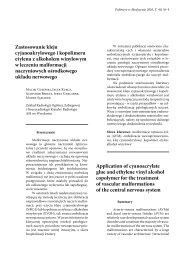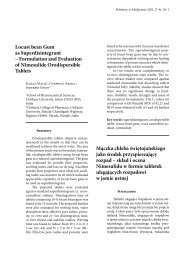peÅna wersja - pdf - Polimery w Medycynie
peÅna wersja - pdf - Polimery w Medycynie
peÅna wersja - pdf - Polimery w Medycynie
You also want an ePaper? Increase the reach of your titles
YUMPU automatically turns print PDFs into web optimized ePapers that Google loves.
14 PIOTR LULIŃSKI i inni[10] Bullinger D., Neubauer H., Fehm T., LauferS., Gleiter C. H., Kammerer B.: Metabolic signatureof breast cancer cell line MCF-7: profilingof modified nucleosides via LC-IT MS coupling.BMC Biochemistry (2007), 8: 25.[11] Seidel A., Brunner S., Seidel P., Fritz G. I.,Herbarth O.: Modifies nucleosides: an accuratetumour maker for clinical diagnosis of cancer,early detection and therapy control. BritishJournal of Cancer (2006), 94, 1726–1733.[12] Jegourel D., Delepee R., Breton F., RollandA., Vidal R., Agrofoglio L. A.: Molecularlyimprinted polymer of 5-methyluridine forsolid-phase extraction of pyrimidine nucleosidecancer markers in urine. Bioorganic and MedicinalChemistry (2008), 16, 8932–8939.[13] Azuma K., Tanaka M., Uekita T., Inoue S.,Yokota J., Ouchi Y., Sakai R.: Tyrosine phosphorylationof paxillin affects the metastaticpotential of human osteosarcoma. Oncogene(2005), 24, 4754–4764.[14] Emgenbroich M., Borrelli C., Shinde S.,Lazraq I., Vilela F., Hall A. J., OxelbarkJ., De Lorenzi E., Courtois J., Simanova A.,Verhage J., Irgum K., Karim K., SellergrenB.: A phosphotyrosine – imprinted polymer receptorfor the recognition of tyrosine phosphorylatedpeptides. Chemistry A European Journal(2008), 14, 9516–9529.[15] Robinson-Bennett B. L., DeFord J., Diaz-ArrastiaC., Levine L., Wang H.-Q., HanniganE. V., Papaconstantinou J.: Implications of tyrosinephosphoproteomics in cervical carcinogenesis.Journal of Carcinogenesis (2008), 7: 2.[16] Bossi A., Bonini F., Turner A. P. F., PiletskyS. A.: Molecularly imprinted polymers for therecognition of proteins: the state of art. Biosensorsand Bioelectronics (2007), 22, 1131–1137.[17] Passos V. M. A., Barreto S. M., Lima-CostaM. F. F.: Detection of renal dysfunction based onserum creatinine levels in a Brazilian community.The Bambui health and ageing study. BrazilianJournal of Medical and Biological Research(2003), 36, 393–401.[18] Harlan R., Clarke W., Di Bussolo J. M., KozakM., Straseski J., Li Meany D.: An automatedturbulent flow liquid chromatography –isotope dilution mass spectrometry (LC-IDMS)method for quantitation of serum creatinine.Clinica Chimica Acta (2010), 411, 1728–1734.[19] Pandey P. C., Mishra A. P.: Novel potentiometricsensing of creatinine. Sensors and ActuatorsB (2004), 99, 230–235.[20] Hsieh R.-Y., Tsai H.-A., Syu M.-J. Designinga molecularly imprinted polymer as an artificialreceptor for the specific recognition of creatininiein serum. Biomaterials (2006), 27, 2083–1089.[21] Laurence A. S.: Serum myoglobin and creatinekinase following surgery. British Journal of Anaesthesia(2000), 84, 763–766.[22] Yamamoto M., Komiyama N., Koizumi T.,Nameki M., Yamamoto Y., Toyoda T., OkunoT., Tateno K., Sano K., Himi T., KuriyamaN., Namikawa S., Yokoyama M., Komuro I.:Usefulness of rapid quantitive measurement ofmyoglobin and troponin T in early diagnosis ofacute myocardial infarction. Circulation Journal(2004), 68, 639–644.[23] Lin H.-Y., Rick J., Chou T.-C.: Optimizing theformulation of a myoglobin molecularly imprintedthin-film polymer – formed using a micro-contactimprinting method. Biosensors andBioelectronics (2007), 22, 3293–3301.[24] Goldstein J. L., Brown M. S.: The LDL receptor.Arteriosclerosis, Thrombosis, and VascularBiology (2009), 29, 431–438.[25] Noda H., Iso H., Irie F., Sairenchi T., OhtakaE., Ohta H.: Association between nonhigh-densitylipoprotein cholesterol concentrationsand mortality from coronary heart diseaseamong Japanese men and women: the Ibarakiprefecture health study. Journal of Artherosclerosisand Thrombosis (2010), 17, 30–36.[26] Shi Y., Zhang J.-H., Shi D., Jiang M., Zhu Y.-X.,Mei S.-R., Zhou Y.-K., Dai K., Lu B.: Selectivesolid-phase extraction of cholesterol using molecularlyimprinted polymers and its applicationin different biological samples. Journal of Pharmaceuticaland Biomedical Analysis (2006), 42,549–555.[27] Higgins J. A.: The transverse distribution ofphospholipids in the membranes of Golgi subfractionsof rat hepatocytes. Biochemistry Journal(1984), 219, 261–272.[28] Yamamoto A.: Phospholipids and their fatty acidcomposition in hyperlipemia. Japanese Journalof Medicine (1975), 14, 104–106.[29] Pegoraro C., Silvestri D., Ciardelli G.,Cristallini C., Barbani N.: Molecularly imprintedpoly(ethylene-co-vinyl alcohol) membranesfor the specific recognition of phospholipids.Biosensors and Bioelectronics (2008), 24,748–755.[30] van Straten A. H. M., Hamad M. A. S., vanZundert A. J., Martens E. J., Schonberger J.P. A. M., de Wolf A. M.: Preoperative hemoglo-
















